I'm highlighting the important parts and new additions now that I have more experience.
I am also adding some topic links within this post:
Diapering Supplies
Basic Cloth Diapers
Wool Soakers
All in One diapers
Washing diapers and covers
I've written before about the fact that we cloth diaper Abigail and how excited I was to order cloth diapers and knit wool soakers before she was born, but I have not yet provided an "inside look" at cloth diapering. I had a friend recently comment that I demonstrate how easy cloth diapering can be. It is easy if you know what you are doing and have support getting started. I am a "self-taught" CDer. That is, I didn't learn from family or friends in person. However, I did learn from other CDing parents online. I did a lot of research concerning different types of diapers, how each works, different covers, cloth wipes and solution, how to clean everything, and even different dirty diaper bin options. I have purposefully tried a wide variety of cloth diaper styles and am now ready to give my opinion on these options. I tried a variety because babies come in different shapes and sizes. Not all diapers work equally well on all babies. I suspect the main leak area around the legs would be the greatest area of difference. A skinny-legged baby would benefit more from one make of diaper than a chubby-legged babe. A heavy wetter would need either a diaper designed for this or added doublers. There is a lot of variety to choose from in style, cut, design - not to mention colours! My collection so far is mild in comparison to what is available.
Diapering Supplies
 This is our diaper station. On the left are the supplies organized in a cloth basket (thanks Kare' and Sherri - I bet you didn't imagine I'd use your gift bag like this):
This is our diaper station. On the left are the supplies organized in a cloth basket (thanks Kare' and Sherri - I bet you didn't imagine I'd use your gift bag like this):cloth wipes made from a baby face cloth stitched to a flannel square (both the facecloth and flannel were prewashed in hot water before sewing because they are washed in hot. The flannel was cut to the subsequently distorted shapes of the cloths.),
the spray bottle of wipes solution (water, olive oil, tea tree oil and lavender),
the snappis (for closing prefold diapers),
and bum balm (a natural, organic herbal balm),
as well as face cloths, baby massage oil, and castor oil (will be stored on a shelf later out of reach). Below the bag are her unbleached prefolds. Under Abigail is a change pad covered with a receiving blanket and often with a prefold under her butt. This way, if she pees or such during changing or while she is having "bum time" to air dry and kick her legs I can wash the cloth (which I have many of) rather than the pad (which I have fewer of). On the right I throw her covers.
Basic Cloth Diapers
Featured in this photo is her (open) Under The Nile organic cotton fitted diaper placed next to Abigail for size comparison. This is a wonderfully soft fabric. It fits nicely, but is rather bulky and takes a long time to dry. As she grew older, it fit much better and with a few washes was less bulky. Still takes longer than my average diaper to dry, but I have some pretty quick-drying diapers. I only have one of these (a gift). While I support the use of organic cotton and I love Under the Nile products (we have a few), I would not buy more of these simply because of their bulk and drying time. I would love to see these made with fold-out liners, like my sugarpeas diapers or bamboozle.
 These are basic prefolds and doublers. On the left is a well-loved cotton prefold. A large bag of these in two sizes were given to me second-hand (actually, third hand at least). I use them more for under Abigail during changes or massages. As a diaper, I find they are too thin. Having washed my own prefolds many many times now, I realize that these were once the same thickness as mine. While they may not be quite as effective now as diapers (unless you add a doubler) as when they were new, they are still great to have around.
These are basic prefolds and doublers. On the left is a well-loved cotton prefold. A large bag of these in two sizes were given to me second-hand (actually, third hand at least). I use them more for under Abigail during changes or massages. As a diaper, I find they are too thin. Having washed my own prefolds many many times now, I realize that these were once the same thickness as mine. While they may not be quite as effective now as diapers (unless you add a doubler) as when they were new, they are still great to have around.On the right is an unbleached hemp doubler that could also be used as a prefold at this stage. I've yet to use these. I keep forgetting to prewash them. Hemp has a lot of natural oils that must be stripped before the diaper can be used. Hemp is more absorbant than cotton, which makes it very useful for during nap or bedtime diapering.
I have found that I don't need doublers for Abigail. At least not yet. However, when I have used them they are great.
 Here is Abigail in a prefold held on with a snappi. Putting on the diaper is simple: place square under her butt, fold the section between her legs in thirds and bring that up to her belly, slightly fan out the thirds and bring the sides up to cross over. Hold in place with the snappi. The snappi is a stretchy plastic device with teeth on each of the three ends. These teeth grab onto the fabric when you stretch the snappi across. The third, center, end tightens the snappi in place.
Here is Abigail in a prefold held on with a snappi. Putting on the diaper is simple: place square under her butt, fold the section between her legs in thirds and bring that up to her belly, slightly fan out the thirds and bring the sides up to cross over. Hold in place with the snappi. The snappi is a stretchy plastic device with teeth on each of the three ends. These teeth grab onto the fabric when you stretch the snappi across. The third, center, end tightens the snappi in place. We also have some fitted diapers. Here is a kooshies cuddlers fitted (given to us second-hand). These fit well around the legs. At her current size I find they are too tall on the rise and bulky at the bottom, but as she grows they will fit better. They claim to fit NB to 22lbs, but I would not recommend them for NB. (Online I see them listed as 10-22lbs, which makes more sense, but the packaging I have says NB). Even at about 11lbs these are big. I found these to be less absorbant, but perhaps this is because they are well-washed with previous usage. I rarely ever used these except as back-up when I ran out of diapers. I am not a big fan of hook-and-loop (velcro) closures for diapers because the hooks catch on everything in the wash. These diapers have no cover for the hooks. I also didn't like how loose they were in the back. These dry in the same time as my unbleached prefolds.
We also have some fitted diapers. Here is a kooshies cuddlers fitted (given to us second-hand). These fit well around the legs. At her current size I find they are too tall on the rise and bulky at the bottom, but as she grows they will fit better. They claim to fit NB to 22lbs, but I would not recommend them for NB. (Online I see them listed as 10-22lbs, which makes more sense, but the packaging I have says NB). Even at about 11lbs these are big. I found these to be less absorbant, but perhaps this is because they are well-washed with previous usage. I rarely ever used these except as back-up when I ran out of diapers. I am not a big fan of hook-and-loop (velcro) closures for diapers because the hooks catch on everything in the wash. These diapers have no cover for the hooks. I also didn't like how loose they were in the back. These dry in the same time as my unbleached prefolds.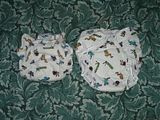 These are Blue Dog diapers (same make as my change pads: dri-line). The Blue Dog on the left was my first experience with cotton fitted diapers. I wasn't particularly impressed with fitteds then, but as she gets older I see the benefits of an elasticized leg hole to allow her greater leg movement. I find the Blue Dogs take a little longer to dry (like the organic cotton), but they are well priced and easy to use. The larger diaper on the right I have yet to use. Several of these were gifted to me. They seem to be an AIO design (see below).
These are Blue Dog diapers (same make as my change pads: dri-line). The Blue Dog on the left was my first experience with cotton fitted diapers. I wasn't particularly impressed with fitteds then, but as she gets older I see the benefits of an elasticized leg hole to allow her greater leg movement. I find the Blue Dogs take a little longer to dry (like the organic cotton), but they are well priced and easy to use. The larger diaper on the right I have yet to use. Several of these were gifted to me. They seem to be an AIO design (see below).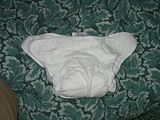 Snug to Fit are another Dri-Line product. I should add that this is a Canadian company. This is a one-size diaper. The snaps on the front allow you to fold down the front section to make the diaper smaller. As baby grows, a second line pf snaps makes the diaper larger and it is at its largest when you no longer need to snap the front down. As with most one-size diapers, these are quite bulky at their smallest size, but not too bad. The benefits, of course, is that one diaper will last until your child potty trains. This diaper also features a loose liner, which allows for quicker drying. This dries in the same time as prefolds. For their price, quality, and length of use, I highly recommend these diapers. They have become my staple diaper now that I nolonger use prefolds and don't need as many diapers. It helps that we practice Elimination Communication.
Snug to Fit are another Dri-Line product. I should add that this is a Canadian company. This is a one-size diaper. The snaps on the front allow you to fold down the front section to make the diaper smaller. As baby grows, a second line pf snaps makes the diaper larger and it is at its largest when you no longer need to snap the front down. As with most one-size diapers, these are quite bulky at their smallest size, but not too bad. The benefits, of course, is that one diaper will last until your child potty trains. This diaper also features a loose liner, which allows for quicker drying. This dries in the same time as prefolds. For their price, quality, and length of use, I highly recommend these diapers. They have become my staple diaper now that I nolonger use prefolds and don't need as many diapers. It helps that we practice Elimination Communication.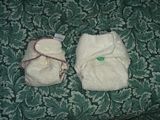 On the left is a sugarpeas fitted hemp diaper. These come in two sizes, both of which are adjustable to cover a long period of diapering. I have size one and size two. Both currently fit her. The liners fold out for quicker drying. I love these Canadian-made diapers. The extra absorbancy of hemp makes them great for night time use. I pair them with a wool soaker cover and they work perfectly to absorb her overnight pees AND allow her skin to breath without having leakage or wet PJs and bedsheets. On the right is a Bamboozle (made in Scotland, but carried by Cdn company Bummis). These are another two-size diaper. I wouldn't bother with a size one because the size two fits from 10lbs to 35lbs, so, unless you really want these for a premie or have a small baby (size one fits 5-18lbs), you can save a lot of money by jumping straight to the size two. It didn't take Abigail long to reach 10lbs! The bamboozle is made from, you guessed it!, bamboo. Bamboo is naturally antibacterial and also super absorbent. These diapers are a terry cloth and delightfully soft. The also have a loose liner that makes for quick drying. I ADORE these diapers. However, I never did buy more. As soft as they are, they don't fit Abigail as well as I would like. But keep in mind, different diapers fit different babies.
On the left is a sugarpeas fitted hemp diaper. These come in two sizes, both of which are adjustable to cover a long period of diapering. I have size one and size two. Both currently fit her. The liners fold out for quicker drying. I love these Canadian-made diapers. The extra absorbancy of hemp makes them great for night time use. I pair them with a wool soaker cover and they work perfectly to absorb her overnight pees AND allow her skin to breath without having leakage or wet PJs and bedsheets. On the right is a Bamboozle (made in Scotland, but carried by Cdn company Bummis). These are another two-size diaper. I wouldn't bother with a size one because the size two fits from 10lbs to 35lbs, so, unless you really want these for a premie or have a small baby (size one fits 5-18lbs), you can save a lot of money by jumping straight to the size two. It didn't take Abigail long to reach 10lbs! The bamboozle is made from, you guessed it!, bamboo. Bamboo is naturally antibacterial and also super absorbent. These diapers are a terry cloth and delightfully soft. The also have a loose liner that makes for quick drying. I ADORE these diapers. However, I never did buy more. As soft as they are, they don't fit Abigail as well as I would like. But keep in mind, different diapers fit different babies. How could I forget my Kissaluv diaper? This is another cozy soft and adorable diaper. It's a shame to cover it. The Kissaluv is very absorbant, but does take longer to dry. I usually hang it to finish drying when all the rest are done, along with the Under the Nile and Blue Dog diapers. I really love this diaper and wish I had more. It fits beautifully because it has wonderful stretch.
How could I forget my Kissaluv diaper? This is another cozy soft and adorable diaper. It's a shame to cover it. The Kissaluv is very absorbant, but does take longer to dry. I usually hang it to finish drying when all the rest are done, along with the Under the Nile and Blue Dog diapers. I really love this diaper and wish I had more. It fits beautifully because it has wonderful stretch.When Abi outgrew her smallest diapers I bought two Mother-Ease Sandy's diapers in bamboo. I LOVE these diapers. In fact, if I were to start anew, I'd buy these instead of the Blue Dogs. They are not bulky (because they are bamboo and thus can get away with less fabric), but they do take a little longer to dry. What I love best is that they snap on the sides. This is very handy when your baby insists on NOT lying down for a diaper change. With snaps, you know which snaps you have to attach together (whereas, with velcro you would need to keep baby still to adjust to the proper fit or risk it falling off) to get the right fit. With side snaps, she can be crawling away, belly to the floor, and you can still attach the diaper. Brilliant. If I have to buy more diapers, I will get more of these.
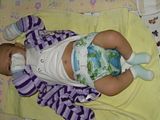 All of the diapers discussed so far require a cover to keep the wetness from leaking or wicking to baby's clothes (and beyond). We use Bummis covers and find that they hold any leaks in. We have also tried the Mother-Ease Rikki wrap covers and they are equally effective at containing everything. I prefer the Bummis for providing a tab to "store" the hook side of the hook-and-loop tape. However, I would ultimately prefer a snap cover or to use all wool soakers. Abigail is showing off her froggies whisper wrap cover over a prefold. She also has white covers and a yellow SuperBrite cover (visible in first picture). We also use the Bummis Whisper Pants, which look more like the old fashioned plastic pants. They are nice for being very thin.
All of the diapers discussed so far require a cover to keep the wetness from leaking or wicking to baby's clothes (and beyond). We use Bummis covers and find that they hold any leaks in. We have also tried the Mother-Ease Rikki wrap covers and they are equally effective at containing everything. I prefer the Bummis for providing a tab to "store" the hook side of the hook-and-loop tape. However, I would ultimately prefer a snap cover or to use all wool soakers. Abigail is showing off her froggies whisper wrap cover over a prefold. She also has white covers and a yellow SuperBrite cover (visible in first picture). We also use the Bummis Whisper Pants, which look more like the old fashioned plastic pants. They are nice for being very thin.Wool Soakers
We also use wool soakers. Wool is very absorbant, naturally antibacterial, and breathes well. When properly lanolized, a wool soaker works by absorbing extra moisture transferred from the diaper and NOT wicking it to the next layer of fabric. Lanolin occurs naturally in sheep wool, however, it is stripped from the wool during processing and must be replaced using a lanolin product such as Lansinoh. The soaker needs to be re-lanolized every few weeks because the urine will break it down. (Did you know that wool used to be processed with human urine?)
Lanolizing and washing the soakers is a simple process that pretty much involves
1) soaking the cover in a wool wash (or wash with other gentle soap such as a bar of olive oil soap or organic baby shampoo and then rinse),
2) resoaking it in warm water with lanolin melted in (to melt the lanolin, squeeze about an inch of Lansinoh per soaker into a jar, add HOT water and a small amount of wool wash or other gentle soap to help break down the lanolin so it can be absorbed, shake the jar well - with lid on of course - and add the mixture to warm water. Your water should look milky. Then add the soaker turned inside out so the inside has the most exposure to the lanolin.)
3) leaving it for a few hours to absorb the lanolin (the soaker should feel sticky after. It can't be too sticky. if it feels too sticky, don't worry, the lanolin will soften your baby's skin and will dissipate on its own),
4) squeezing out excess water by rolling in a towel, and
5) laying or hanging over something wide to dry.
If the cover gets poopy, I just soak the spot and wash it with a bar of olive oil soap, then lanolize.
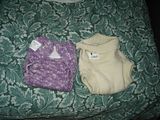
These are our store-bought wool soakers. The purple is AJ'z Wonderful Wool Soaker (from Grace at Forever Family). This is a nice wool wrap cover, but I prefer a pull-on style. The off-white is an Aristocrats "bum sweater" wool soaker. I had heard many great things about this soaker and I must agree that it is a fabulous choice! This is a pull-on style cover. It's frequently called a bum sweater because it is roomy. Unlike a wrap-style cover and the other pull-ons I've made (below), the Aristocrats does not have to fit snugly all around to stay on. Abigail is not a particularly heavy wetter, but every review I have read praises the ability of this soaker to handle a wet diaper, particularly during naps/bedtime.
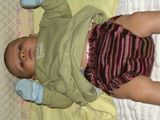 Abigail models her Warm Heart Woolies (WHW) wrap cover, knit by me (as are all of the wool soakers to follow). This did not fit well at first - there were gaping spaces around her leg - until she grew more. I used a simple button closure system, but a hook-and-loop ("Velcro") closure would make it more adjustable. I didn't want to sew on hook and loop tape. Now that she fits it, I really like this wrap and it is extremely quick to make. However, because it does not fit snugly around her legs, I use it only with fitteds rather than with a prefold because this leg would not hold in anything trying to sneak out of a diaper.
Abigail models her Warm Heart Woolies (WHW) wrap cover, knit by me (as are all of the wool soakers to follow). This did not fit well at first - there were gaping spaces around her leg - until she grew more. I used a simple button closure system, but a hook-and-loop ("Velcro") closure would make it more adjustable. I didn't want to sew on hook and loop tape. Now that she fits it, I really like this wrap and it is extremely quick to make. However, because it does not fit snugly around her legs, I use it only with fitteds rather than with a prefold because this leg would not hold in anything trying to sneak out of a diaper.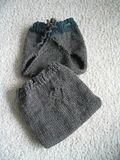
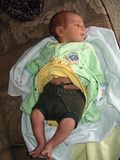 My first soakers were a simple triangle pattern in newborn size. I made them for my sister, but she never used them. She sent them back to me for Abigail and I really liked them. These are another very simple pattern - knit a triangle with a ribbed top; bring the bottom corner up to the top, stitch closed leaving leg holes. I made one extra special by adding a heart design to the bum.
My first soakers were a simple triangle pattern in newborn size. I made them for my sister, but she never used them. She sent them back to me for Abigail and I really liked them. These are another very simple pattern - knit a triangle with a ribbed top; bring the bottom corner up to the top, stitch closed leaving leg holes. I made one extra special by adding a heart design to the bum. The Punk Rock Knitter pattern is very similar in the end to the triangle, except it is knit in the round to start with a panel that comes up between the legs and is kitchener stitched for a more clean look.
The Punk Rock Knitter pattern is very similar in the end to the triangle, except it is knit in the round to start with a panel that comes up between the legs and is kitchener stitched for a more clean look.
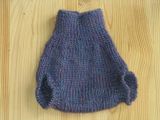
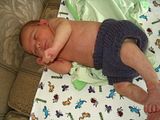
The Curly Purly is my favourite pattern so far. This is knit in the round. My first attempt (left)was frogged after I finished. It's a beautiful yarn, but it is mixed with soy and soy fiber, while absorbant, would wick the moisture to the next layer of fabric. All plant-based fibers will wick moisture. This is why one should use 100% wool for soakers, because wool will not wick the moisture, it will just absorb it (when lanolized). The Curly Purly was still a little big for Abigail when I put it on her in the picture above. It fits much better now. I have since made her another one (since she outgrew the first) using Peace Fleece wool. I highly recommend this wool because it holds its shape very well and does not pill as much as the Patons Classic Merino I have usually used. The Curly Purly is still my favourite pattern, hands down.
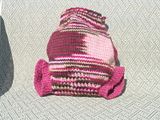
This is a revised version of the TinyBirds Organics soaker pattern. The original pattern is for toddlers and the revised version fits smaller. It should fit Abigail at around 6 months I think. This is another good pattern. I think the greatest problem I found with this is my choice of yarn (Patons Classic Merino), which stretched.
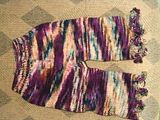 My Sheepy Pants (aka longies) were made using the first pattern I have ever purchased online. This pattern comes highly recommended by other wool-soaker knitters, and I fully agree with their endorsements. The pattern is clear and easy to follow. Knitting these was a breeze. I'll certainly be making more. Note to self - get knitting on those shorties and longies! Wool pants can be worn directly over a diaper without need for a pair of pants overtop. Wool is warm in winter and COOL in summer because it breathes.
My Sheepy Pants (aka longies) were made using the first pattern I have ever purchased online. This pattern comes highly recommended by other wool-soaker knitters, and I fully agree with their endorsements. The pattern is clear and easy to follow. Knitting these was a breeze. I'll certainly be making more. Note to self - get knitting on those shorties and longies! Wool pants can be worn directly over a diaper without need for a pair of pants overtop. Wool is warm in winter and COOL in summer because it breathes.
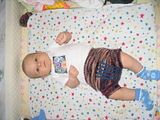 I found this wool soaker pattern on Ravelry and loved it because it uses a DK weight wool (which I have a stash of) and adds extra wool, in the form of stripes, to be more absorbant. The pattern asserts this would fit approx 6-18m depending on diaper, but this is entirely not true. This fits snugly on Abigail now at 10 weeks. It also needs a slightly higher rise. But otherwise I love the pattern and the resulting soaker. Look how cute it is in the bum! I would make it again. Now that I have a base model I can easily resize it. It really was a great soaker, but she outgrew it quickly. I passed it on to a friend who loved it. I did make one a size larger, but used Patons again (why oh why), not yet realizing how badly it can stretch. I have a lot of Patons Classic Wool in my stash I was planning to use, but as I type this I realize I really should use it for something else and get more Peace Fleece for the soakers. Don't worry, it'll get used.
I found this wool soaker pattern on Ravelry and loved it because it uses a DK weight wool (which I have a stash of) and adds extra wool, in the form of stripes, to be more absorbant. The pattern asserts this would fit approx 6-18m depending on diaper, but this is entirely not true. This fits snugly on Abigail now at 10 weeks. It also needs a slightly higher rise. But otherwise I love the pattern and the resulting soaker. Look how cute it is in the bum! I would make it again. Now that I have a base model I can easily resize it. It really was a great soaker, but she outgrew it quickly. I passed it on to a friend who loved it. I did make one a size larger, but used Patons again (why oh why), not yet realizing how badly it can stretch. I have a lot of Patons Classic Wool in my stash I was planning to use, but as I type this I realize I really should use it for something else and get more Peace Fleece for the soakers. Don't worry, it'll get used.I have since crocheted two styles of soakers. One a DC pattern with a skirty option (I test knit this pattern and did add the skirt) another a SC pattern that has become my favourite. It is very quick to make and I've made one for Abi and two as gifts (since Abi doesn't need more). I have used Patons Merino for these. The weight works very well and the fabric doesn't lose its shape when crocheted as it does when knit with this yarn. Good use of that Patons stash!
The DC pattern is by WiggleBunz. It is cute, but I'm not as fond of waistbands made separately. It is also a paid pattern.
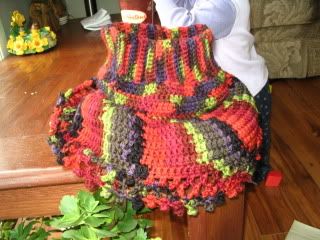
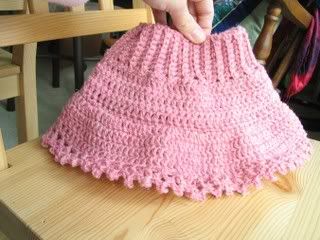
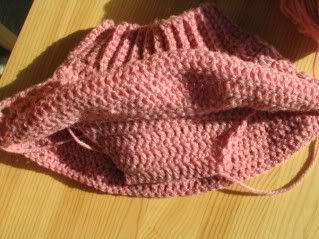
This was my test knit using a heavier weight yarn. I didn't like how it turned out with this yarn, especially on the skirtie. It was frogged. But I liked the pattern enough to make it again (above) in Patons Merino.
The SC pattern is the Little Fire soaker, which also comes with a skirtie option. I really like this pattern, which uses DCs for shaping. Also, it's free! This is my first recommendation to friends who want to crochet a soaker.
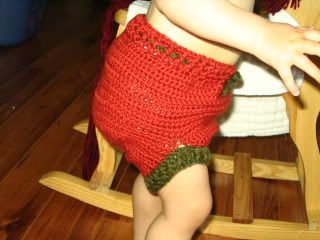 Here is Abi's scraps soaker
Here is Abi's scraps soaker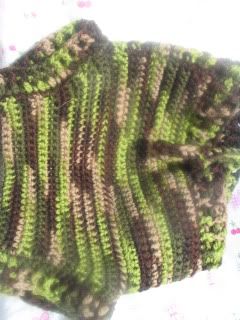 And this one is a new one to be gifted soon. I made another but didn't take any decent photos.
And this one is a new one to be gifted soon. I made another but didn't take any decent photos.All In One diapers
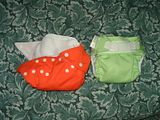
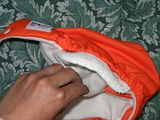 Finally we come to my AIO (all in one) diapers. Both styles I have are pocket diapers. As shown above, there is a pocket in which an absorbent layer is inserted. These come with microfiber inserts, but you could also use a prefold or doubler. The outer layer is PUL. It does not require a cover because this layer keeps moisture in. The inner layer is a soft microfleece fabric that pulls moisture away from Abbie's bum. I could also buy similar liners for my other diapers, but haven't yet because she is changed frequently. She lets me know when her diaper is dirty.
Finally we come to my AIO (all in one) diapers. Both styles I have are pocket diapers. As shown above, there is a pocket in which an absorbent layer is inserted. These come with microfiber inserts, but you could also use a prefold or doubler. The outer layer is PUL. It does not require a cover because this layer keeps moisture in. The inner layer is a soft microfleece fabric that pulls moisture away from Abbie's bum. I could also buy similar liners for my other diapers, but haven't yet because she is changed frequently. She lets me know when her diaper is dirty.The orange diaper is a Fuzzi Bunz in size small. The green is a BumGenius one-size diaper shown at its smallest setting. Unlike other one-size diapers, the bumgenius is not extra bulky.
Both my AIO styles have pocket inserts, but there are also AIO styles that do not have a removable layer. Some people prefer these, but I've never tried them for a comparison. There are some truly gorgeous handmade AIOs I'd love to buy though! I have heard complaints that removing the insert in pocket AIOs is "gross" or difficult. I've never had a problem. At worst I have to grab the insert from the top (and yes I feel it is damp, but this is no worse than grabbing a wet prefold), but usually I can just hold it upside down and shake it out. One store owner ranted to me about how hard these are to clean. I suspect she and other complainers simply didn't know how to do it right, because myself and others haven't had problems with stinky pocket diapers. I separate the inserts from the rest of the diaper.
Washing Diapers
Which leads me to diaper pails. I use a dry diaper pail system with two bins. In the main bin, a regular rubbermaid kitchen stepcan, I have a Wahmies liner. These are the best pail liners! In this bin I throw dirty cloths, prefolds, fitteds, and inserts. In the other plastic, lidded bin I put dirty covers and pocket diapers (minus the insert). When the main bin is full, I take the pocket diapers from the other bin, toss them in the bag, and bring the entire bag down to the laundry machine where I dump the contents into a cold water wash. (I also add our cloth tissues to the load.) My diapers get a cold water wash and rinse (or prewash) without detergent followed by a hot wash with about 2 tbsp of detergent and a cold rinse. All is then transferred to the dryer on medium for 50 minutes with dryer balls. At that point the wipes and AIOs are done, so I remove them to reduce the bulk drying and reset the dryer on regular for another 20-30 minutes. Or, I may hang them to dry on a sunny day. I occasionally sun-bleach my diapers to get them white (or off-white for unbleached) again by hanging them in the sun. This is preferable to using bleach or other chemical treatments (which I do not use).
Covers are washed with other laundry according to their wash instructions at a warm temp (I like to use a cold prewash still), although the whisper and brite wraps could go in with her diapers.
While the diapers are being cleaned, I line the main pail with my second Wahmies liner (btw, there are Canadian retailers for these) and begin to fill it with the never-ending dirty diapers :) When we are not at home I use a jamtots zippered wet bag to store her dirty diapers. I tried another bummis-like style of wet bag but didn't like it at all. (Wahmies makes a similar wet bag, but the store I was at only had JamTots, which are a Canadian company - a plus.)
That about covers my cloth diapering experience. There are many great work at home mothers (WAHMs) making these products in Canada (and the US and elsewhere) and providing excellent advice, tips, and help for cloth diapering families. If you are considering CDing your child, or if you know someone expecting a child who you'd like to encourage to cloth diaper, check out all the great online resources. I can't even begin to list them for you (Google does that well enough), but you are welcome to ask me for some more links. If, like me, you prefer to buy local or Canadian, then JamTots is a great place to start (I only just now checked out their page) because not only do they have a great variety of products, but they also have helpful articles. Parenting by Nature is another favourite Canadian online store of mine and a great source of information.
No comments:
Post a Comment